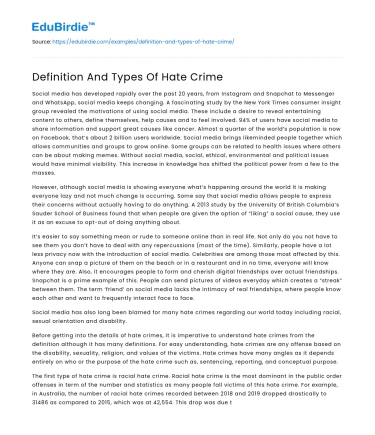Social media has developed rapidly over the past 20 years, from Instagram and Snapchat to Messenger and WhatsApp, social media keeps changing. A fascinating study by the New York Times consumer insight group revealed the motivations of using social media. These include a desire to reveal entertaining content to others, define themselves, help causes and to feel involved. 94% of users have social media to share information and support great causes like cancer. Almost a quarter of the world’s population is now on Facebook, that’s about 2 billion users worldwide. Social media brings likeminded people together which allows communities and groups to grow online. Some groups can be related to health issues where others can be about making memes. Without social media, social, ethical, environmental and political issues would have minimal visibility. This increase in knowledge has shifted the political power from a few to the masses.
However, although social media is showing everyone what’s happening around the world it is making everyone lazy and not much change is occurring. Some say that social media allows people to express their concerns without actually having to do anything. A 2013 study by the University Of British Columbia’s Sauder School of Business found that when people are given the option of “liking” a social cause, they use it as an excuse to opt-out of doing anything about.
Save your time!
We can take care of your essay
- Proper editing and formatting
- Free revision, title page, and bibliography
- Flexible prices and money-back guarantee
It’s easier to say something mean or rude to someone online than in real life. Not only do you not have to see them you don’t have to deal with any repercussions (most of the time). Similarly, people have a lot less privacy now with the introduction of social media. Celebrities are among those most affected by this. Anyone can snap a picture of them on the beach or in a restaurant and in no time, everyone will know where they are. Also, it encourages people to form and cherish digital friendships over actual friendships. Snapchat is a prime example of this. People can send pictures of videos everyday which creates a “streak” between them. The term ‘friend’ on social media lacks the intimacy of real friendships, where people know each other and want to frequently interact face to face.
Social media has also long been blamed for many hate crimes regarding our world today including racial, sexual orientation and disability.
Before getting into the details of hate crimes, it is imperative to understand hate crimes from the definition although it has many definitions. For easy understanding, hate crimes are any offense based on the disability, sexuality, religion, and values of the victims. Hate crimes have many angles as it depends entirely on who or the purpose of the hate crime such as, sentencing, reporting, and conceptual purpose.
The first type of hate crime is racial hate crime. Racial hate crime is the most dominant in the public order offenses in term of the number and statistics as many people fall victims of this hate crime. For example, in Australia, the number of racial hate crimes recorded between 2018 and 2019 dropped drastically to 31486 as compared to 2015, which was at 42,554. This drop was due to many campaigns and civic education by the government to the people and the pressure from the international communities. The racial hate crime is so common, since it does not cause physical harm to the victims, but it has mental and emotional damage to the victims.
Another type of hate crime is the sexual orientation and gender, People in the society today are declaring their sexual orientation as gay, lesbian or straight. However, other people do not like to have their sexual orientation known which might lead to confusion of a persons’ sexuality. Hate crime again sexuality arises when a victim is mistaken as one who belongs to a given sexual orientation, which is against his or her actual sexual orientation. In 2018 and 2019, sexual orientation crimes rose from 312 to 357 offenses. This increase was due to the varying changes in definition and incidences by people as people realised the development of sexual and gender hate crimes.
Finally, disability hate crime is another category of hate crime. This hate crime varies as it depends entirely on the definition of the disability. People with mental impairment, physical disability or visual impairment are the victims of this hate crime as they consistently face stigmatisation from society.
It’s said that information is power and in today’s world, this power is distributed among everyone and not just a selected few. Everyone knows what’s happening in the world, whose destroying trees or which countries are launching nukes. This spread of information helps everyone make educated decisions based on what’s happening and not just what they’re told. However, social media results in hate crimes in today’s society including racial, sexual orientation and disability. Hate crimes have adverse effects on these victims and sometimes can lead to the death of the victims if they do not get help. Educating the people on hate crimes is important, as it will help reduce stigmatisation and prevalence of the crime since people will be aware of hate crime and its consequences. Thus, our relationship with what’s real and fake are slowly being changed from face to face and physical to digital.
The word “friends” is also losing its meaning.






 Stuck on your essay?
Stuck on your essay?

